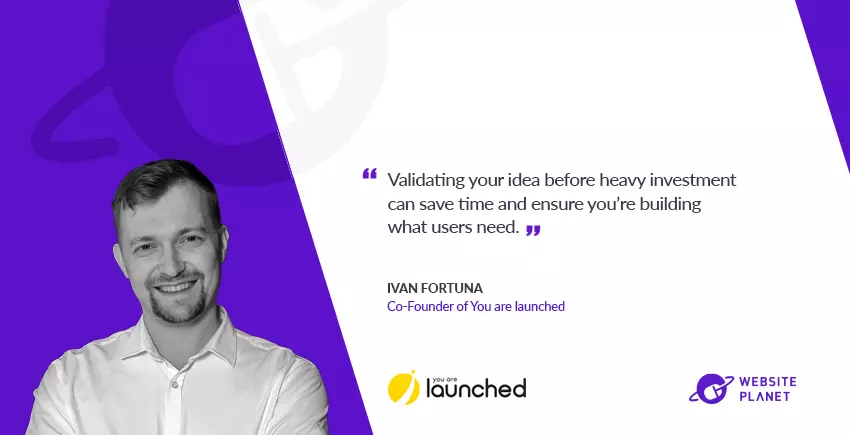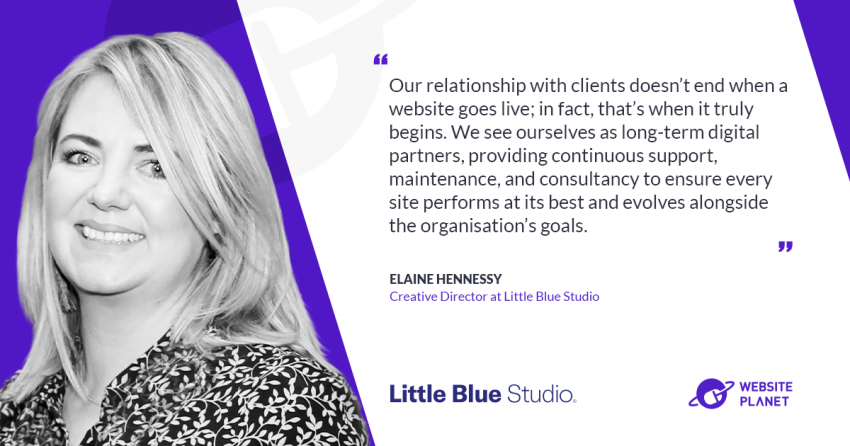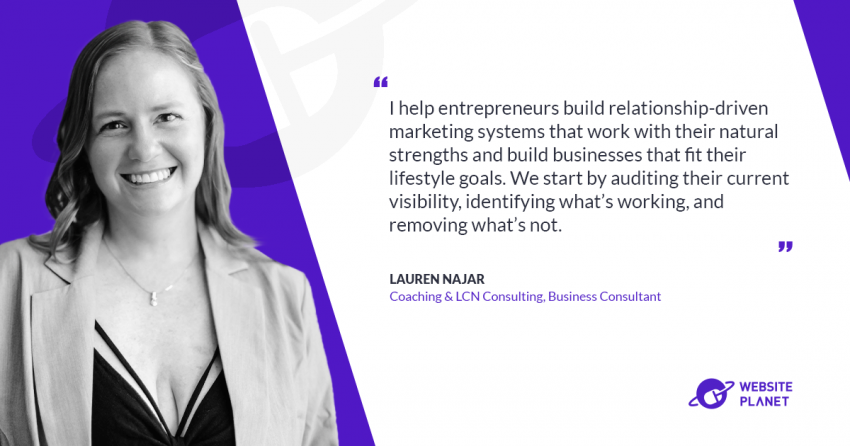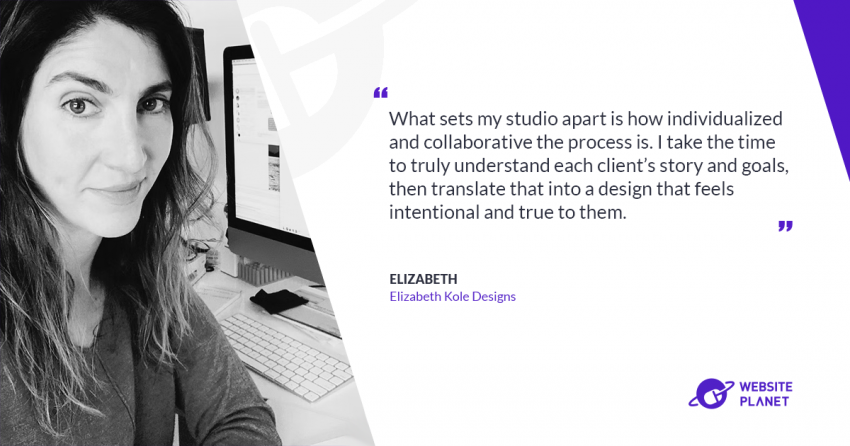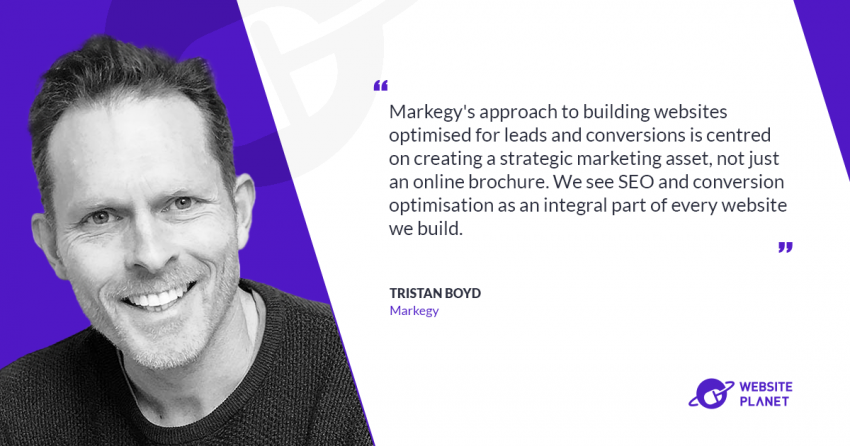In this interview series by Website Planet, I talk to executives from the best digital companies, who share their stories, tips, and perspectives on what it really takes to create a successful website and online business. A deep dive into decades of hands-on experience and technical expertise to learn untold truths and practical advice that will immediately help you build and grow your website.
Ivan Fortuna is the co-founder of You are launched, a company focused on helping startups validate business ideas quickly and without massive investments. Before founding You are launched, Ivan held various roles in tech at companies like RubyGarage, InMotion Soft, and 111Minutes. He also participated in the Y Combinator program from 2016 to 2017.
To start, tell us briefly about you. What is your current role at your company, and what are the measurable achievements you are most proud of?
I’m a co-founder of You are launched, a business that helps convert startup ideas into reality through MVP building and app launching. My job encompasses overseeing every aspect of the development process from planning all the way to launching the final product and this entails working with the clients in order to bring their ideas into successful products.
One of the measurable goals I am proud of is that we have launched more than 70 startups with 20 of them turning into profit within 12 months. In addition, we have been noted for the ability to deliver high quality apps within shortest period of time by Techreviewer and The Manifest. Understandably, the emphasis on speed and affordability first of all helped the clients to attract the very first rounds of investment and enabled to scale their businesses effectively. Most of them, thanks to this, were able to establish long-lasting relations, turning their stage 1 MVPs into fully functioning platforms.
What pain point(s) do you solve for your customers? What was the “aha Moment” that led to the idea? Can you share that story with us?
What we at You are launched focus on is one of the most troublesome problems for any startup: how to deliver a new concept to the market in the fastest, most efficient and least risky manner. Many founders have this dilemma about their product – will users actually care about it, before they invest considerable time and money into development? This is where our philosophy, which is based on Lean Startup of Eric Ries, comes into play.
By focusing on the build-measure-learn loop, we enable our clients to bring an MVP together swiftly and source real user feedback as early as possible. It gives room for adjustments, hence minimizing risks of failure, and ascertaining the product addresses a problem it’s set to solve for its target audience. One of the most memorable ‘aha moments’ came early on when working with a client on Wishew, a social crowdfunding platform. Using the Lean Startup method, we were able to deliver an MVP to them that helped them secure $10 million in funding-a strong validation of just how powerful this methodology can be in helping startups prove their concept, pivot if necessary, and build a product users genuinely want.
What do you think makes your company stand out? What are you most proud of?
What makes You Are Launched unique is our all-around support for startups, from development to investment. We apply the Lean Startup methodology by delivering MVPs fast and efficiently without sacrificing Scrum’s agility for adaptations according to real users’ feedback. Along with our technical services, we also offer partial service coverage investing to minimize the upfront costs for founders.
What is unique to our service is in fact the network of investors: once a startup starts to show some real traction, we hook them up with hungry investors looking for an in, a line into funding that few startups ever find on their own. This holistic support system combines rapid development with financial backing to position our clients for long-term success and scalability.
From your experience, what are the most important things to build a highly successful website and online business? Please explain each in detail.
Based on my experience, for creating a very successful website and online business, what is required is a strategic approach not only to the types of users but also to the various stages of the business lifecycle.
Here’s how we break that down:
1. Clear Value Proposition for Target Users
Any website should be able instantly to tell about its value for some type of user. Whether you are targeting Innovators or early adopters (who usually are your first users) you want to describe the core offering of your product in a manner that really speaks their language. At this stage, these users are looking for innovation and a solution for their unique pain points, so they can adopt a new product even with limited features.
2. User-Centric Design & Experience
UX is key to early adopters and pragmatists. A clean, intuitive website where navigation is easy will allow the user to build trust and convert. Users in the early majority are less lenient, and they want a seamless experience. The simplicity of design, speed, and accessibility will be the key things to focus on. Moving into the late majority, your website should also articulate a more polished and stable platform for their expectations.
3. Phased Development: Idea Validation to Scaling
You are launched adheres to the Lean Startup methodology, structuring projects in the following phases: Idea Validation, MVP Development, and Scaling. During the website idea validation phase, the primary concentration would be on capturing user interest to test your core ideas. The website MVP should be launched with just enough features to give value to the Innovators and Early Adopters while at the same time, you can measure the responses of those users. After you hit good product traction, you will be able to scale the website by adding on new features and going after the Early Majority and Late Majority users.
4. SEO & Content Strategy Tailored to Business Growth
The Idea Validation stage is where your content strategy needs to focus on Innovators and Early Adopters, implementing SEO tactics to increase visibility and drive organic traffic. Moving into the MVP and Scaling stages of your business, your content strategy will need to shift toward targeting much wider audiences, focusing more on case studies, blogs, and user testimonials, while establishing authority and trust as you shift toward the Late Majority user group.
5. Agile Iteration and Continuous Feedback
From the Build-Measure-Learn loop, which is so crucial at every point in development, to launching an MVP as quickly as possible, you can then measure feedback from Early Adopters, validate your assumptions, and iterate. As you gather feedback and metrics, you will understand better what is valued by your audience and how to enhance the website as your business grows.
If there were one part of the website development process you would have spent 50% more time on, what would it be and why? What made you realize the importance of this step?
It would definitely be the Idea Validation stage. This is the most crucial stage, as it allows us to experiment with different aspects related to audience targeting, positioning, design concepts, and even the core value proposition. It is at this stage that we get a bunch of priceless views on what resonates with target users and enables us to fine-tune the product before going into full development.
What really makes this stage important is its flexibility: we can spend more time here, running experiments that confirm our assumptions about the audience – whether that’s Innovators, Early Adopters, or another segment –, or testing various design elements and messaging to find what generates the greatest engagement. This can be iterative to help make sure that, when we go on to develop the thing, we are still confident it will meet market demand and user expectations.
Through the idea validation stage, we have saved our clients a great deal of time and money by predetermining what will work and what will not right from the very beginning. It is not about making a pretty-looking website; rather, it is about crafting something for a very real problem for actual users that could scale well. This also reduces the risk of redesigns or pivots that may cost a fortune later on and hence positions the MVP or full product for success right from the word go.
What’s the one key lesson you’ve learned about building a website and business that you wish you knew when you started? What’s the story behind this realization?
Validate your idea before investing too much in development. I think in the case of my own startup, that really had to do with execution: building a product that looked great, and had all the features we thought people wanted. But what I’ve learned over time is that the best-designed website or business model won’t matter if you don’t take the time to validate your assumptions as to who your target audience is, and what problem you’re trying to solve.
This lesson actually comes from a story with one of our very first projects, where we dove straight into development without taking the time to do the Idea Validation stage. We intended to make a feature-rich site, but at the launch, we felt the level of engagement was much lower than anticipated. It became clear that we hadn’t understood our audience’s needs yet and had missed key opportunities to hook them. We thus had to go back to redesigning elements based on actual user feedback, thereby making the project take more time and be more costly.
Since then, we adopted the Lean Startup methodology, and that is where all the difference was made. That means to this date we validate ideas through experiments, A/B testing, and feedback with users, just to make sure that the base is solid before we do full-scale development. Thus, it saved us and our clients from unnecessary pivots, and helped us to create products that would really resonate with their users.
In your opinion, which aspect of running a website tends to be most underestimated? Can you explain or give an example?
Optimization and iteration on an ongoing basis are one of the most underestimated phases of maintaining a website. Many people think that if a website is live, then that is where the work ends. In reality, it is just the beginning. The most successful websites are those that have changed continuously in response to user behavior, feedback, and data analysis.
A very good example of this is the Build-Measure-Learn loop of the Lean Startup methodology. This iterative approach provides for testing any feature, design change, or updating of content for iterative optimization to cater to the needs of users. In one of our very first projects, we launched a website with what we thought was a good design and set of features. But when it was finally on air, we felt users weren’t engaging in certain sections as anticipated. Rather than letting it stay the same, we A/B tested some new layouts and messaging, and the results were significant: 25% positive change in conversion rates.
That means data-driven iteration is key. Using tools like Google Analytics, heat maps, and user surveys, one can iteratively work on improvement of the user experience, enhancing engagement, and thereby growing one’s business. Failing to do this means failing in the pursuit of opportunities to enhance one’s website performance.
What are the most common mistakes you have seen people making when building their website and online business? What can be done to avoid those errors?
1. Idea Validation StageSkipped
Most founders dive directly into development without the validation of the idea in advance. They assume they know what their audience wants without gathering feedback or testing assumptions. Doing so can waste time and resources on developing features or a design that does not resonate with users. I highly recommend doing small tests during the Idea Validation stage, like A/B testing of landing pages, feedback gathering with surveys, or even releasing a minimal MVP in order to test demand. The Lean Startup approach is indeed one of the most viable methods to ensure that what you are building is indeed what the market wants.
2. Focus Too Much on Design and Not Enough on User Experience
It’s very easy to get caught up in making a website look beautiful, but if it isn’t intuitive or easy to navigate, users will quickly lose interest. I have seen websites with stunning visuals that ultimately failed due to users not being able to find what they needed or the loading times being too long. At the end of the day, you need to make sure user experience (things like mobile responsiveness, fast page load speeds, and clear navigation) is prioritized. Tools like heat maps or user journey analysis can help you to identify at which point users are struggling and make improvements accordingly.
3. Insufficient Investment in SEO and Content Strategy
Insufficient investment in SEO and content right from the very outset is another very common mistake. A nicely designed website counts for little if people cannot find it. Businesses become so focused on design and functionality that often they forget to incorporate arguably the most important tool in acquiring organic traffic: SEO. A good content strategy entails blogging, guides, and product page optimization that ultimately helps in getting better visibility on search engines and allows businesses to establish credibility in their respective fields. Adding new content on a consistent basis based on trending keywords and user interests will help in securing long-term growth.
4. Overcomplicating the Website
Over-targeting can overwhelm the users, and it would be hard to manage the website. It is also true that we have worked with a number of clients who wished to include a number of features up front, only to find when testing the MVP with real users that much simpler, core functionalities were more valuable. To avoid this, focus on building the essentials first and add more features as you learn what users need.
By avoiding these mistakes, businesses can take a more structured approach to designing the website using data as their guide. By doing so, not only will it look nice, but it will also serve the business’s goals.
What strategy has been particularly effective in growing your website audience this year?
A combination of content-driven SEO, accompanied by really targeted user engagement has been one of the most effective strategies that we’ve used in growing our website audience this year. By focusing on the creation of high-quality, value-driven content that is relevant to our specific user segments (innovators, Early Adopters, and Pragmatists), we have been able to increase our organic traffic significantly.
We will implement a robust content strategy: comprehensive blog posts, case studies, and success stories that are optimized for key industry-relevant search terms. This is done by analysing the pain points a target audience has at every stage in the journey of a startup, to create traffic-attracting, user-engaging, trust-building content.
A/B testing and the acquisition of user feedback have been other key parts of our growth strategy. We are constantly testing different layouts on the website, messaging, and CTAs to see which one resonates best with our audience. This data-driven approach has empowered us to raise engagement rates and provide the best possible experience for users, which in turn drives repeat visitors and referrals.
If I asked you to share the key ingredient in your “secret sauce” for inbound marketing, what would it be?
That would be personalized, value-driven content speaking to their particular stage of development. It means we create content for Innovators, Early Adopters, and Pragmatists that speaks to their unique pain points and provides actionable insights to help move them further along their buying journey.
Our strategy for inbound is based on our continuous assessment of where each user type currently falls in their journey to found a startup and presenting them with relevant solutions – be it educational blog posts, case studies of successful projects we’ve done, or even interactive tools that will help founders validate their ideas. What we have seen is that once this content is not just educational but focused on the immediate needs of the user, it builds a lot more trust and drives better engagement.
The second ingredient is consistency. We’ve made our messaging consistent, right from the website to social media and newsletters, making for a seamless experience with our audience. We have been offering real upfront value while maintaining visibility and clarity in our message. This has allowed us to take website visitors and transform them into loyal clients.
Based on your experiences, what trends and technologies are currently underestimated or overlooked, but can significantly impact your industry? How are you going to adapt?
Probably the most underestimated, in my opinion, is that of AI-driven tooling for product development and user engagement. While a lot of hype is going on with artificial intelligence and machine learning, their actual applications within a startup ecosystem – particularly automation of user behavior analysis, personalized content delivery, or optimization of app performance – are yet to be embraced by many. This could be huge for efficiency, scalability, and customer retention.
At You are launched, we adapt by infusing these technologies into our processes. We’re already evaluating AI-driven analytics that will help us better arm our clients with data-backed decisions around their MVPs. We will also be including no-code tools into our workflow in order to provide faster iterations for clients in the early stages of development. If tapped correctly, this can speed up the road to market and bring large efficiencies for startups.
How can our readers follow your work?
Website: www.urlaunched.com
LinkedIn: https://www.linkedin.com/company/urlaunched/
X: https://x.com/urlaunched
Dribbble: https://www.dribbble.com
Behance: https://www.behance.net
